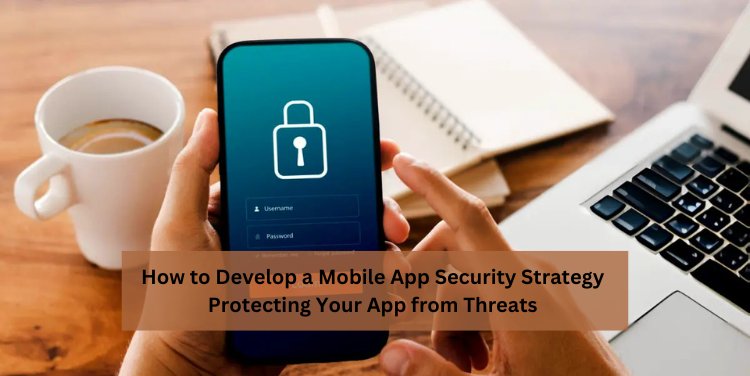How to Develop a Mobile App Security Strategy: Protecting Your App from Threats

With the rise of mobile app usage, security has become a top priority. Mobile apps handle sensitive data, perform critical functions, and often connect to broader networks and systems, making them prime targets for cybercriminals. Developing a robust mobile app security strategy is essential to protect your app, data, and users from potential threats. Here’s a guide on how to build a strong security foundation for your mobile app.
-
Conduct a Comprehensive Security Assessment Start by conducting a thorough security assessment. This should include identifying potential risks, threats, and vulnerabilities specific to your app and industry. Key areas to examine include data storage, authentication mechanisms, network communications, and permissions. Steps Perform a threat modeling exercise to understand the specific threats your app may face. Analyze your app’s data flow to pinpoint where sensitive data may be at risk. Consider both technical and business risks, such as data breaches and regulatory non-compliance.
-
Implement Strong Authentication and Authorization Secure authentication and authorization mechanisms are the foundation of mobile app security. These mechanisms help ensure that only authorized users can access sensitive areas of the app. Best Practices Use multifactor authentication (MFA) to add an extra layer of security. Implement session management techniques to prevent unauthorized access, such as setting session timeouts. Consider using biometrics (fingerprint or face ID) for enhanced security, especially for apps handling sensitive data.
-
Encrypt Sensitive Data Data encryption is essential for protecting user data both at rest and in transit. Encrypted data ensures that, even if intercepted, it cannot be easily read by unauthorized parties. Encryption Tips Use strong encryption protocols such as AES-256 for data at rest. For data in transit, ensure that all communications are sent over secure HTTPS connections with TLS. Store encryption keys securely and separate them from the encrypted data to prevent unauthorized decryption.
-
Secure the API Layer Most mobile apps rely on APIs to communicate with servers and databases. Securing these APIs is critical, as they are a common attack vector for cybercriminals. API Security Tips Authenticate and authorize every API request using tokens, such as OAuth. Implement rate limiting to prevent abuse or denial-of-service attacks. Regularly audit APIs for vulnerabilities and remove unused or deprecated endpoints to minimize attack surfaces.
-
Minimize Permissions and Access Controls Only request permissions that are essential for the app’s functionality. Over-permissioned apps are more susceptible to attacks and increase the risk of data exposure. Best Practices Adopt the principle of least privilege, only granting users and the app the minimum level of access required. Monitor and audit permission requests to detect any abnormal behaviors. Educate users on why specific permissions are necessary, which builds trust and transparency.
-
Apply Secure Coding Practices Secure coding practices reduce the likelihood of introducing vulnerabilities during development. Many security issues, such as SQL injection and buffer overflows, can be prevented with secure coding techniques. Tips Validate all user inputs to prevent injection attacks. Avoid hardcoding sensitive data, such as API keys and credentials, directly into your code. Use secure libraries and frameworks that have been tested and are regularly updated to mitigate common vulnerabilities.
-
Regularly Test and Update the App Mobile apps should undergo regular testing to identify and resolve vulnerabilities. These updates should address newly discovered threats and apply patches to existing security weaknesses. Testing Techniques Perform regular static and dynamic code analysis to detect potential vulnerabilities in the code. Use penetration testing to simulate attacks and identify any exploitable weaknesses. Encourage a bug bounty program where ethical hackers can report security flaws in exchange for rewards.
-
Implement Data Protection and Privacy by Design Protecting user data and respecting privacy should be at the core of your app’s architecture. Following privacy by design principles helps in meeting regulatory standards such as GDPR and HIPAA. Data Protection Tips Anonymize or pseudonymize data wherever possible to protect user identity. Collect only the data you absolutely need and inform users about how their data will be used. Include privacy controls that allow users to manage their data, such as deleting or downloading their information.
-
Secure App Distribution The app distribution process itself can be a security risk if not managed properly. Ensuring that users are downloading the official app from trusted sources is crucial. Distribution Tips Publish your app only on trusted platforms, such as Google Play and the Apple App Store. Use code-signing certificates to verify the integrity and authenticity of your app. Regularly monitor app stores for any unofficial versions or clones that could harm your brand and users.
-
Implement User Education and Awareness Educating users about security practices is essential for ensuring they use your app securely. By helping users recognize threats like phishing attacks, you empower them to be the first line of defense. User Education Tips Provide clear instructions on how to use security features, such as MFA, within the app. Inform users about best practices for password management and online security. Regularly communicate any updates to security policies and encourage users to update the app frequently.
Conclusion Developing a comprehensive mobile app security strategy is essential to protect your app and users from cyber threats. By adopting proactive security measures, testing regularly, and educating users, you can significantly enhance the resilience of your app against evolving security risks. A strong security strategy not only protects your app but also builds user trust, positioning your brand as reliable and committed to safeguarding user data.
What's Your Reaction?















